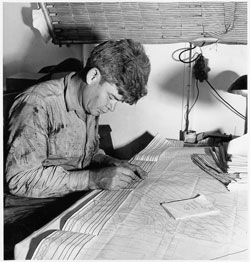Maurice Ewing facts for kids
Quick facts for kids
Maurice Ewing
|
|
|---|---|

Maurice Ewing in 1948. Photo courtesy Columbia University
|
|
| Born |
William Maurice Ewing
May 12, 1906 |
| Died | May 4, 1974 (aged 67) |
| Nationality | American |
| Alma mater | Rice University |
| Awards | Alexander Agassiz Medal (1954) William Bowie Medal (1957) Cullum Geographical Medal (1961) John J. Carty Award (1963) Wollaston Medal (1969) National Medal of Science (1973) Vetlesen Prize (1960) Fellow of the Royal Society (1972) Penrose Medal (1974) |
| Scientific career | |
| Fields | geophysics underwater acoustics oceanography |
| Institutions | Lehigh University Columbia University University of Texas |
| Thesis | Calculation of ray paths from seismic travel-time curves (1931) |
| Doctoral advisor | Harold A. Wilson |
| Influenced | J. Lamar Worzel Frank Press Jack Nafe Jack Oliver Bruce Heezen |
William Maurice "Doc" Ewing (born May 12, 1906 – died May 4, 1974) was an American scientist. He was a leading expert in geophysics and oceanography. Geophysics is the study of Earth's physical processes. Oceanography is the study of the ocean.
Ewing was a pioneer in many areas. He studied how sound waves travel through the ocean. He also took photos of the ocean floor. He collected core samples from the deep sea. He researched earthquake waves and the Earth's core. He also mapped the ocean floor and studied sedimentation.
Biography
Maurice Ewing was born in Lockney, Texas. He was the oldest child in a large farming family. He was very smart and won a scholarship to attend Rice University. He earned his first degree there in 1926. He continued his studies at Rice, getting his master's degree in 1927. He then earned his Ph.D. in 1931.
In 1928, he married Avarilla Hildenbrand. They had one son together. Later, in 1944, he married Margaret Sloan Kidder. They had four children. In 1965, he married his third wife, Harriet Greene Bassett.
Ewing taught at Rice Institute while working on his Ph.D. In 1930, he joined the faculty at Lehigh University. He stayed there until 1944. At Lehigh, he helped start a new program in geophysics.
In 1947, he moved to Columbia University. He became a professor of geology there. People who worked with him often called him 'Doc'. In 1949, he started the Lamont Geological Observatory. This is now known as the Lamont-Doherty Earth Observatory (LDEO). It is located in Palisades, New York.
At LDEO, he worked with many other scientists. These included J. Lamar Worzel, Dr. Frank Press, Jack Nafe, Jack Oliver, Dr. Bruce Heezen, and Marie Tharp. They made many important discoveries about the Earth and oceans.
A research vessel called the R/V Maurice Ewing was named in his honor. This ship helped scientists explore the oceans.
In 1972, he moved to the University of Texas Medical Branch in Galveston, Texas. He became the head of the Earth and Planetary Sciences Division. This division was part of the Marine Biomedical Institute.
During his career, Maurice Ewing wrote over 340 scientific papers. He also led more than 50 expeditions to the ocean. He made many important contributions to oceanography. He discovered the SOFAR Channel. This is a layer in the ocean where sound travels very far. He also invented the sofar bomb, which helped study this channel. His work was very important for understanding plate tectonics. Plate tectonics is the theory that Earth's outer shell is made of large plates that move.
Ewing also worked on Project Mogul. This was an early program to detect nuclear weapons tests. He was the chief scientist on board the Glomar Challenger. This ship drilled into the ocean floor to collect samples.
Maurice Ewing passed away in 1974 in Galveston, Texas.
Awards and Honors
Maurice Ewing received many awards for his important work. Here are some of them:
- Penrose Medal, 1974 (given after he died)
- Walter H. Bucher Medal, 1974
- William Bowie Medal, 1957
- Arthur L. Day Medal, 1949
- John J. Carty Award from the National Academy of Sciences, 1963
- National Medal of Science, 1973
- Vega Medal from the Swedish Society for Anthropology and Geography, 1965
- Cullum Geographical Medal from the American Geographical Society, 1961
- Gold Medal of the Royal Astronomical Society, 1964
- Vetlesen Prize, 1960
He was also elected to many important scientific groups. These include the National Academy of Sciences and the Royal Society.
The Geophysics Laboratory at the University of Texas Medical Branch Marine Science Institute was renamed Maurice Ewing Hall. Two important awards, the Maurice Ewing Medals, are also named after him. These medals are given by the Society of Exploration Geophysicists and the American Geophysical Union. Even a lunar wrinkle ridge called Dorsa Ewing is named after him!
See also
In Spanish: Maurice Ewing para niños

